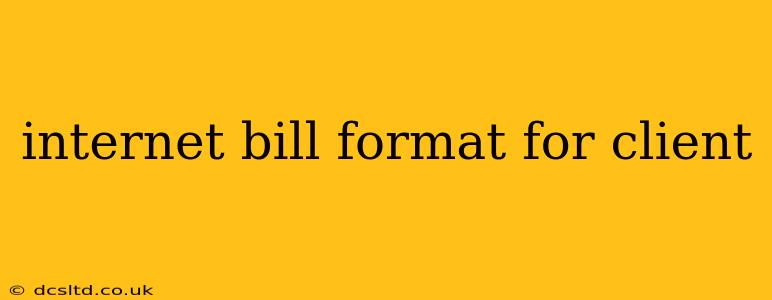Creating a professional and clear internet bill is crucial for maintaining positive client relationships and ensuring smooth financial transactions. This guide will walk you through the essential components of a well-structured internet bill format, covering everything from basic information to advanced features. We'll also address common questions surrounding billing practices.
What Information Should Be Included in an Internet Bill?
A well-designed internet bill should be easy to understand and provide all the necessary information at a glance. Here's a breakdown of the key elements:
-
Header: Your company logo, name, address, phone number, and email address should be prominently displayed at the top.
-
Client Information: Clearly state the client's name, account number, service address, and contact information. Accuracy is paramount here to avoid billing errors.
-
Billing Period: Specify the exact dates covered by the bill (e.g., "Billing Period: October 1, 2023 - October 31, 2023").
-
Service Details: This section outlines the internet plan the client is subscribed to, including the speed (e.g., 100 Mbps), data allowance (if applicable), and any additional services (e.g., static IP address, VoIP).
-
Charges: Itemize all charges clearly. This includes the base internet service fee, any additional charges (e.g., late fees, equipment rentals), taxes, and other applicable fees. Use descriptive labels to avoid confusion.
-
Payment Details: Include the total amount due, the due date, and accepted payment methods (e.g., check, credit card, online payment). Provide clear instructions on how to make a payment.
-
Account Summary: Provide a concise summary of the account's status, including outstanding balance, payment history, and any upcoming changes to the service.
-
Contact Information: Reiterate your company's contact information for customer support inquiries and billing questions.
-
Footer: This might include disclaimers, legal information, or your company's website address.
How to Organize the Information for Clarity
Consider using a tabular format to clearly present the charges. This makes it easy for clients to review and understand the breakdown of their bill. For instance:
| Description | Quantity | Rate | Total |
|---|---|---|---|
| Internet Service (100 Mbps) | 1 | $59.99 | $59.99 |
| Modem Rental | 1 | $5.00 | $5.00 |
| Taxes | $5.10 | ||
| Total Amount Due | $69.09 |
What Are Some Common Questions About Internet Bills?
Here are some frequently asked questions about internet bills that you should anticipate and address on your bill or through customer support:
What if a client disputes a charge?
Clearly outline your process for handling disputes. Provide contact information and a method for submitting a formal dispute.
How are late fees calculated?
Explicitly state your late payment policy, including the amount of the late fee and any grace periods.
What happens if the payment is not received?
Explain the consequences of non-payment, such as service interruption or account suspension.
What payment methods are accepted?
List all acceptable payment methods clearly, including any online payment portals or third-party processors.
How can clients access their billing history?
If possible, provide a way for clients to access their past bills online through a customer portal.
By addressing these common concerns proactively, you can build trust and improve client satisfaction. Remember that a well-designed internet bill is more than just a financial statement; it's a reflection of your company's professionalism and commitment to excellent customer service. Creating a clear, concise, and easy-to-understand bill can significantly enhance client relations and minimize disputes.
